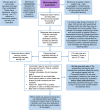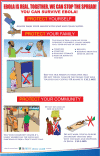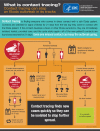Social Mobilization and Community Engagement Central to the Ebola Response in West Africa: Lessons for Future Public Health Emergencies
- PMID: 28031301
- PMCID: PMC5199179
- DOI: 10.9745/GHSP-D-16-00226
Social Mobilization and Community Engagement Central to the Ebola Response in West Africa: Lessons for Future Public Health Emergencies
Abstract
Following the World Health Organization (WHO) declaration of a Public Health Emergency of International Concern regarding the Ebola outbreak in West Africa in July 2014, UNICEF was asked to co-lead, in coordination with WHO and the ministries of health of affected countries, the communication and social mobilization component-which UNICEF refers to as communication for development (C4D)-of the Ebola response. For the first time in an emergency setting, C4D was formally incorporated into each country's national response, alongside more typical components such as supplies and logistics, surveillance, and clinical care. This article describes the lessons learned about social mobilization and community engagement in the emergency response to the Ebola outbreak, with a particular focus on UNICEF's C4D work in Guinea, Liberia, and Sierra Leone. The lessons emerged through an assessment conducted by UNICEF using 4 methods: a literature review of key documents, meeting reports, and other articles; structured discussions conducted in June 2015 and October 2015 with UNICEF and civil society experts; an electronic survey, launched in October and November 2015, with staff from government, the UN, or any partner organization who worked on Ebola (N = 53); and key informant interviews (N = 5). After triangulating the findings from all data sources, we distilled lessons under 7 major domains: (1) strategy and decentralization: develop a comprehensive C4D strategy with communities at the center and decentralized programming to facilitate flexibility and adaptation to the local context; (2) coordination: establish C4D leadership with the necessary authority to coordinate between partners and enforce use of standard operating procedures as a central coordination and quality assurance tool; (3) entering and engaging communities: invest in key communication channels (such as radio) and trusted local community members; (4) messaging: adapt messages and strategies continually as patterns of the epidemic change over time; (5) partnerships: invest in strategic partnerships with community, religious leaders, journalists, radio stations, and partner organizations; (6) capacity building: support a network of local and international professionals with capacity for C4D who can be deployed rapidly; (7) data and performance monitoring: establish clear C4D process and impact indicators and strive for real-time data analysis and rapid feedback to communities and authorities to inform decision making. Ultimately, communication, community engagement, and social mobilization need to be formally placed within the global humanitarian response architecture with proper funding to effectively support future public health emergencies, which are as much a social as a health phenomenon.
© Gillespie et al.
Figures










References
-
- World Health Organization (WHO). Statement on the 1st meeting of the IHR Emergency Committee on the 2014 Ebola outbreak in West Africa. WHO Statement. Geneva: WHO; 8 August 2014: http://www.who.int/mediacentre/news/statements/2014/ebola-20140808/en/
-
- World Health Organization (WHO). Statement on the 9th meeting of the IHR Emergency Committee regarding the Ebola outbreak in West Africa. WHO Statement. Geneva: WHO; 29 March 2016. Available from: http://www.who.int/csr/disease/ebola/response/en/
-
- World Health Organization (WHO). WHO Situation Report: Ebola Virus Disease. Geneva: WHO; 10 June 2016. Available from: http://apps.who.int/iris/bitstream/10665/208883/1/ebolasitrep_10Jun2016_...
-
- UNICEF. UNICEF Situation Reports: Guinea, Liberia, Sierra Leone. New York: Unicef; 29 February 2016. [Unpublished].
-
- Dhillon RS, Kelly JD. Community trust and the Ebola endgame. New England Journal of Medicine. 2015; 373:787–789. - PubMed
MeSH terms
LinkOut - more resources
Full Text Sources
Other Literature Sources
Medical
